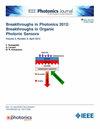Sensitivity and Noise Analysis of Resonant All-Fiber Optic Current Transformers
IF 2.1
4区 工程技术
Q3 ENGINEERING, ELECTRICAL & ELECTRONIC
引用次数: 0
Abstract
The sensitivity and noise of an all-fiber optic current transformer (AFOCT) scheme named resonant AFOCT are analyzed, which senses the current information by measuring the frequency difference between clockwise and counterclockwise resonances inside a fiber ring resonator (FRR). Compared with polarization-type and interference-type AFOCT, the sensitivity of the resonant AFOCT can be improved by increasing the finesse of the FRR. The mathematical model of the resonant AFOCT is established, and the sensitivity expression of the resonant AFOCT limited by the sensitivity of the photodetector is derived. For the small current measurement of 1 mA level, the carrier suppression level of phase modulation is required to be better than谐振全光纤电流互感器的灵敏度和噪声分析
该方案通过测量光纤环谐振器(FRR)内顺时针和逆时针谐振之间的频率差来感测电流信息。与偏振型和干涉型 AFOCT 相比,谐振型 AFOCT 的灵敏度可以通过提高 FRR 的精细度来改善。本文建立了谐振式 AFOCT 的数学模型,并推导出谐振式 AFOCT 受限于光电探测器灵敏度的灵敏度表达式。对于 1 mA 级的小电流测量,要求相位调制的载流子抑制水平优于 ${{\rho }_{\text{ccw}}}{{\rho }_{\text{cw}}}{\rm{ = }}。- \mathrm{110 \, dB}$,并且 FRR 的无用偏振特征态强度应被抑制到小于 -68 dBm。光纤四分之一波板的非理想特性和纺丝光纤的残余线性双折射主要影响谐振 AFOCT 的比例因子。谐振 AFOCT 将是实现电流互感器高精度的重要途径。
本文章由计算机程序翻译,如有差异,请以英文原文为准。
求助全文
约1分钟内获得全文
求助全文
来源期刊

IEEE Photonics Journal
ENGINEERING, ELECTRICAL & ELECTRONIC-OPTICS
CiteScore
4.50
自引率
8.30%
发文量
489
审稿时长
1.4 months
期刊介绍:
Breakthroughs in the generation of light and in its control and utilization have given rise to the field of Photonics, a rapidly expanding area of science and technology with major technological and economic impact. Photonics integrates quantum electronics and optics to accelerate progress in the generation of novel photon sources and in their utilization in emerging applications at the micro and nano scales spanning from the far-infrared/THz to the x-ray region of the electromagnetic spectrum. IEEE Photonics Journal is an online-only journal dedicated to the rapid disclosure of top-quality peer-reviewed research at the forefront of all areas of photonics. Contributions addressing issues ranging from fundamental understanding to emerging technologies and applications are within the scope of the Journal. The Journal includes topics in: Photon sources from far infrared to X-rays, Photonics materials and engineered photonic structures, Integrated optics and optoelectronic, Ultrafast, attosecond, high field and short wavelength photonics, Biophotonics, including DNA photonics, Nanophotonics, Magnetophotonics, Fundamentals of light propagation and interaction; nonlinear effects, Optical data storage, Fiber optics and optical communications devices, systems, and technologies, Micro Opto Electro Mechanical Systems (MOEMS), Microwave photonics, Optical Sensors.
 求助内容:
求助内容: 应助结果提醒方式:
应助结果提醒方式:


